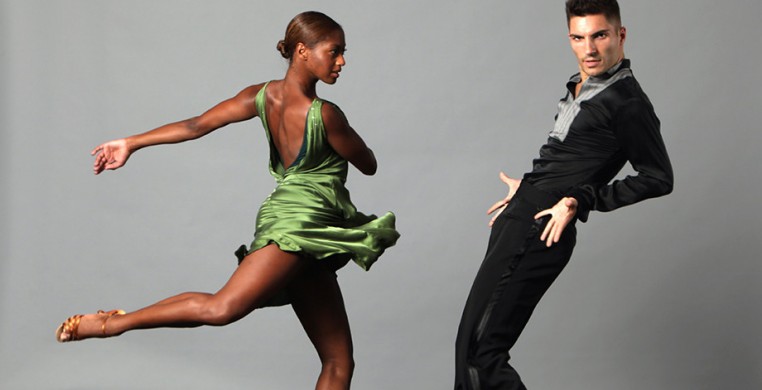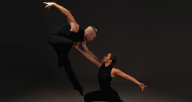Live vocal and instrumental music lit a fire in a company that was already cooking, in Giordano Dance Chicago’s eclectic spring season this past weekend. The dancers’ keen musicality and connection to the music sparkled throughout the concert of past repertoire and new work.
From Autumn Eckman’s crowd-pleaser, Jolt (2012), where dancers syncopate complex body rhythms with their own caffeinated tap-tapping of spoons on coffee mugs and the fabulous live percussion performance of composer Evan Bivins and Matt Martin, to Sabroso (2011), Del Dominguez and Laura Flores’ steamy Latin Ballroom finish, the dancers sang with a total body and soul, go-to-the-limits Giordano energy and love of movement. Sandwiched between were Jon Lehrer’s showcase for GDC’s impressive men, Like 100 Men (2002), and Lindsey Laduc’s Gravity (2009), a happy love duet performed with freewheeling abandon by Rachael Berube and Sean Rozanski to the voice of songwriter Sara Bareilles.
Song and the sound of the human voice infused the evening in a thoroughly integrated blend of music and dance. It was a pleasure to revisit company director Nan Giordano’s Taal (2001), with the hauntingly beautiful on-stage singing of vocalist Sheetal Heinert in traditional Asian Indian garb. John Imburgia’s new lighting added texture and focus to the pillars of white fabric suspended from above, which integrated choreography and scenic design in patterns that painted the space with ever-changing geometrics, both human and cloth. The fabric wasn’t just decoration. Giordano made ingenious use of it to both propel and reflect the movement, to conceal and reveal, with the dancers grabbing hold of the panels and running, spiraling, crisscrossing, spinning, suspending, catching, leaping and falling.
The blend of vocal music and dance was especially poignant in Mist (world premiere), by Autumn Eckman, GDC resident choreographer and assistant artistic director, with music composed by Eric Whitacre and sung by 26-voice Bella Voce, live on stage. Set to poems by Octavio Paz and Edward Esch, fragile tones of choral music spun invisible threads from the very fingertips of the dancers’ outstretched arms. As individual voices separated from the choral mass of sound, then merged and recombined, so did the dancers, moving from individual gesture to unison movement. It was as if there were a choir of dancers and a corps de ballet of vocalists creating a primordial world of alternating dissonance and harmony. Emily Nelson’s simple body-suits, nude-tone with painted vines wrapping around pelvis and groin, suggested a Garden of Eden innocence that focused on the natural beauty of the human form. The movement, as quiet as the sound of rain magically produced by the singers’ snapping fingers, was lush with elongated lines, reaching, stretching, beseeching, and effortless horizontal lifts. A floating, dream quality, in obeisance to the poem’s plea: We must dream with our hands....we must sing till the song/ casts roots....Mist reaches a stunning climax in a thunder storm of sound and motion that builds to a frenetic pitch of flailing arms and fleeing lifts. As the storm subsides, dancers are drawn toward the singers, and the singers to the dancers, until they merge and listen to each other with their bodies. A light reveals one dancer who remains on the floor, separate from the rest. A woman emerges from the indistinguishable mass of singers and dancers to embrace him. He comes to life for an exquisite duet, danced by Maeghan McHale and Joshua Blake Carter with understated tenderness and a physical vulnerability that transcended technical brilliance. How can an arabesque mean so much? When it is attenuated beyond the imagination until it reaches into a realm of love and human contact that can sustain itself in a single balance for eternity.
Lynn Colburn Shapiro - March 31, 2014


